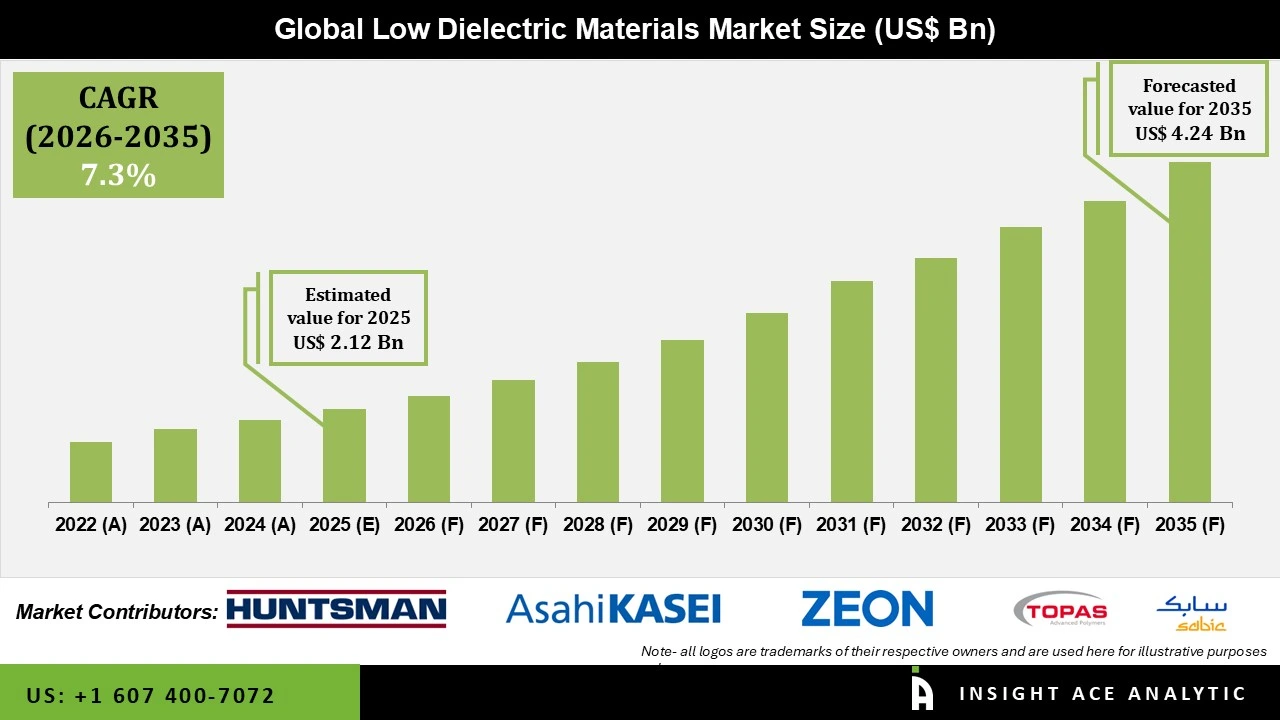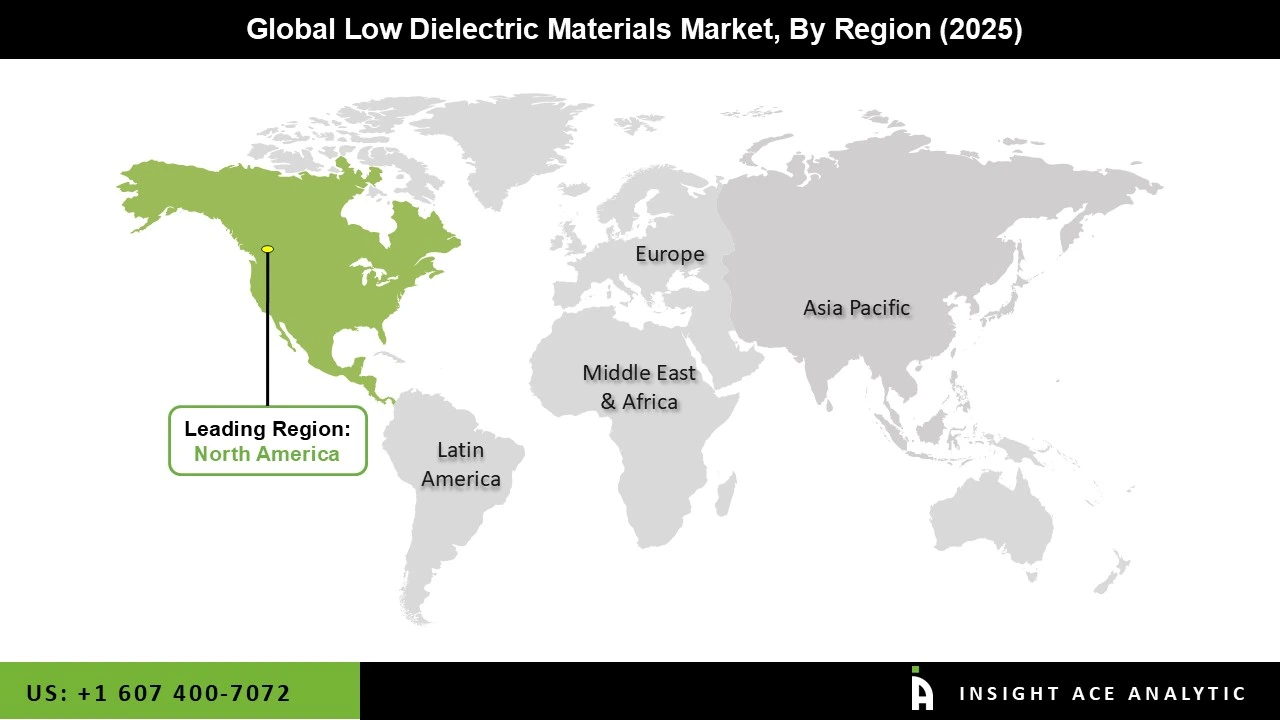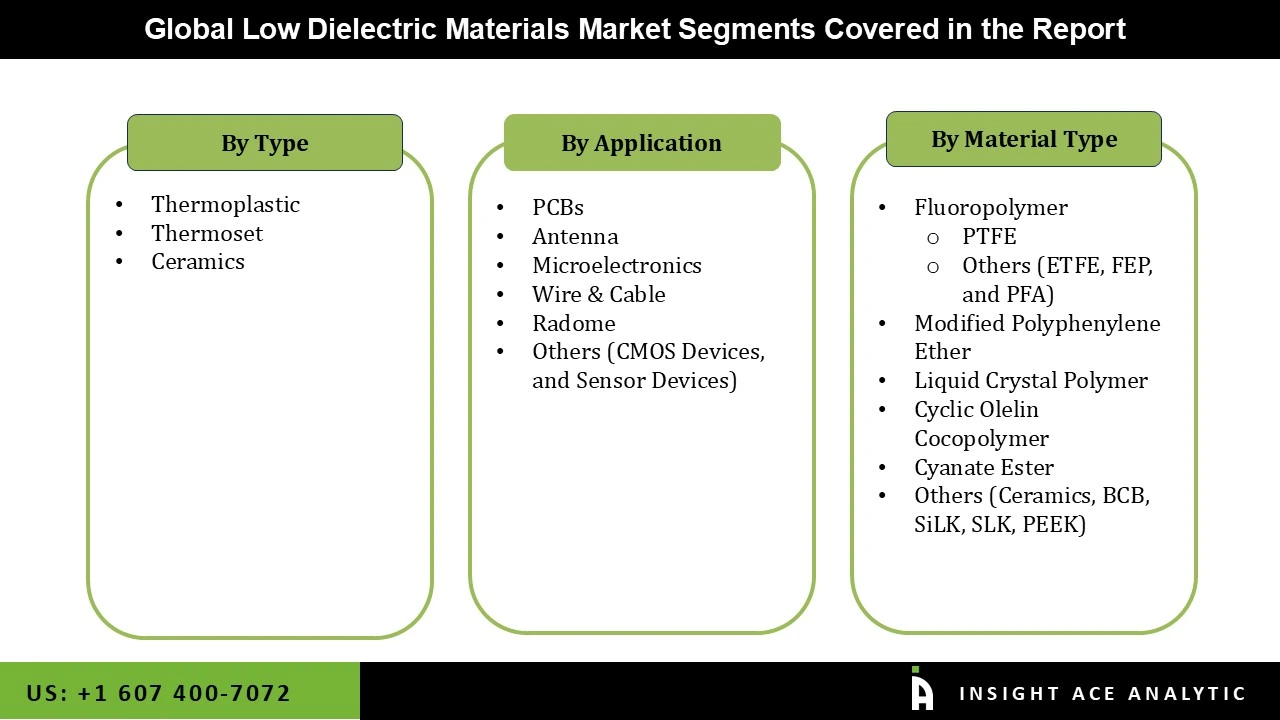Global Low Dielectric Materials Market Size is valued at USD 2.12 Bn in 2025 and is predicted to reach USD 4.24 Bn by the year 2035 at an 7.3% CAGR during the forecast period for 2026 to 2035.
Low Dielectric Materials Market Size, Share & Trends Analysis Report By Type (Thermoplastic, Thermoset, Or Ceramics), Material (Fluoropolymer, Modified, Polyphenylene, Ether, Liquid Crystal Polymer, Cyclic Olelin Copolymer, Polyimide, Cyanate Ester, Modified Polyphenylene Ether), By Application, By Region, And Segment Forecasts, 2026 to 2035.

The term "thermoset materials" describes substances that, as a result of a chemical reaction triggered by heat, a catalyst, UV light, and other elements, will or have become essentially infusible. The various materials used in PCBs, antennae, microelectronics, wire and cable, radomes, and other products include fluoropolymer, modified polyphenylene ether, polyimide, cyclic olefin copolymer, cyanate ester, liquid crystal polymer, and others.
Equipment for 5G networks, such as antenna interlayers, cables, and communication devices, are frequently made with low dielectric constant resins. Materials that are dielectric function as electric insulators and can store electric charges. They act as a container for short-term charge storage.
As a result, the market for low-dielectric materials is expanding due to the arrival of 5G communications. The primary trend that is gaining traction in the market for low-dielectric materials is new technological developments. To maintain their place in the market, major players are offering new technological items that are produced utilizing optimum electrical technology.
Low Dielectric Material Market Players:
The low dielectric materials market is segmented into type, material and application. Based on type, the market is segmented into thermoplastic, thermoset, or ceramics. Based on material type, the market is segmented into fluoropolymer (PTFE, Others), modified, polyphenylene, ether, liquid crystal polymer, cyclic olelin copolymer, polyimide, cyanate ester, modified polyphenylene ether, and others. Based on application, the market is segmented into PCBs, antenna, microelectronics, wire & cable, radome, and others (CMOS Devices, and Sensor Devices).
The fact that thermosets can easily take on a stable structure and have good resistance to deformation when heated is a major factor in the rise in demand for them. These resins are particularly well suited for the production of printed wire boards since they also provide significant strength, durability, and electrical resistance. On the other hand, easily recyclable thermoplastics are also being used widely as the movement of sustainability gains hold around the world.
The low dielectric material market is divided into PCBs, antennae, microelectronics, wire & cable, radome, and others based on applications. The largest end use for low-dielectric materials at the moment is PCBs. Low dielectric materials are employed as the linking insulator material between the PCB terminals, allowing for little crosstalk and low signal loss. The need for low-dielectric materials is anticipated to rise dramatically during the forecast period as PCB demand picks up steam globally.
During the forecast period, North America is expected to provide the largest income. The market has expanded as a result of a number of causes, such as the rising need for electronic product downsizing, increased demand for radar and antennas due to increased air traffic, and the development of autonomous vehicles and 5G connectivity. Dielectric displays are being used more frequently in household appliances, mobile phones, and other consumer electronics, which is the cause of this rise.

Besides, due to the rising need for the production of electronic components like PCBs and microelectronics, the Asia Pacific is the region where the market for low-dielectric materials is expanding at the quickest rate. Additionally, increased air traffic has increased the need for antennas in the area, which further increases the demand for low-dielectric materials.
| Report Attribute | Specifications |
| Market size value in 2025 | USD 2.12 Bn |
| Revenue forecast in 2035 | USD 4.24 Bn |
| Growth rate CAGR | CAGR of 7.3% from 2026 to 2035 |
| Quantitative units | Representation of revenue in US$ Bn, Volume (Kiloton), and CAGR from 2026 to 2035 |
| Historic Year | 2022 to 2024 |
| Forecast Year | 2026-2035 |
| Report coverage | The forecast of revenue, the position of the company, the competitive market statistics, growth prospects, and trends |
| Segments covered | Type, Application |
| Regional scope | North America; Europe; Asia Pacific; Latin America; Middle East & Africa |
| Country scope | U.S.; Canada; U.K.; Germany; China; India; Japan; Brazil; Mexico; The UK; France; Italy; Spain; China; Japan; India; South Korea; Southeast Asia; South Korea; Southeast Asia |
| Competitive Landscape | Huntsman Corporation, Arxada, Sabic, Asahi Kasei, Topas Advanced Polymers, Zeon Corp, The Chemours Company, DIC Corporation, Arkema, Mitsubishi Chemical Corporation, Showa Denko Material Group, DOW, Shin-Etsu Chemical Co., LTD., Olin Corporation, Celanese Corporation, Solvay, Flucorcarbon, Chenguang Research Institute of Chemical Industry, Dakin Industries LTD, Polyonics, Inc, Circuit Companies Supplies LTD, Yunda Electronics Materials Co., LTD, Liyang, Huajing Electronic Material Co., LTD, Victrex, Nanjing Qingyan Polymer New Materials LTD. |
| Customization scope | Free customization report with the procurement of the report, Modifications to the regional and segment scope. Particular Geographic competitive landscape. |
| Pricing and available payment methods | Explore pricing alternatives that are customized to your particular study requirements. |
Low Dielectric Materials Market By Type-

Low Dielectric Materials Market By Material type-
Low Dielectric Materials Market By Application-
Low Dielectric Materials Market By Region-
North America-
Europe-
Asia-Pacific-
Latin America-
Middle East & Africa-
This study employed a multi-step, mixed-method research approach that integrates:
This approach ensures a balanced and validated understanding of both macro- and micro-level market factors influencing the market.
Secondary research for this study involved the collection, review, and analysis of publicly available and paid data sources to build the initial fact base, understand historical market behaviour, identify data gaps, and refine the hypotheses for primary research.
Secondary data for the market study was gathered from multiple credible sources, including:
These sources were used to compile historical data, market volumes/prices, industry trends, technological developments, and competitive insights.

Primary research was conducted to validate secondary data, understand real-time market dynamics, capture price points and adoption trends, and verify the assumptions used in the market modelling.
Primary interviews for this study involved:
Interviews were conducted via:
Primary insights were incorporated into demand modelling, pricing analysis, technology evaluation, and market share estimation.
All collected data were processed and normalized to ensure consistency and comparability across regions and time frames.
The data validation process included:
This ensured that the dataset used for modelling was clean, robust, and reliable.
The bottom-up approach involved aggregating segment-level data, such as:
This method was primarily used when detailed micro-level market data were available.

The top-down approach used macro-level indicators:
This approach was used for segments where granular data were limited or inconsistent.
To ensure accuracy, a triangulated hybrid model was used. This included:
This multi-angle validation yielded the final market size.
Market forecasts were developed using a combination of time-series modelling, adoption curve analysis, and driver-based forecasting tools.
Given inherent uncertainties, three scenarios were constructed:
Sensitivity testing was conducted on key variables, including pricing, demand elasticity, and regional adoption.